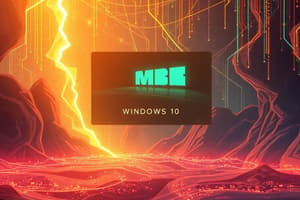Podcast
Questions and Answers
What is one limitation of the Legacy BIOS compared to UEFI?
What is one limitation of the Legacy BIOS compared to UEFI?
- Capable of accommodating drives larger than 2.2 TB
- Supports booting from USB drives
- Cannot handle data drives larger than 2.1 TB (correct)
- Enables secure access to BIOS user interface functions
Which type of BIOS is able to support drives larger than 2.2 TB?
Which type of BIOS is able to support drives larger than 2.2 TB?
- BIOS User Interface
- UEFI (correct)
- Legacy BIOS
- MS-DOS
What initiates the functions used to operate and control system peripherals in the BIOS library?
What initiates the functions used to operate and control system peripherals in the BIOS library?
- UEFI firmware
- Internal memory
- BIOS hardware
- External software (correct)
How can a user access the BIOS setup during the computer's startup process?
How can a user access the BIOS setup during the computer's startup process?
Which file is created in the root of the boot drive by the MS-DOS setup?
Which file is created in the root of the boot drive by the MS-DOS setup?
What does the UEFI acronym stand for?
What does the UEFI acronym stand for?
What is the purpose of the CONFIG.SYS and AUTOEXEC.BAT files during system boot?
What is the purpose of the CONFIG.SYS and AUTOEXEC.BAT files during system boot?
In the boot procedure, what does the small program loaded into memory do?
In the boot procedure, what does the small program loaded into memory do?
What key combination is commonly used for a warm reboot in legacy systems?
What key combination is commonly used for a warm reboot in legacy systems?
What is required for a cold reboot if Ctrl+Alt+Del has no effect?
What is required for a cold reboot if Ctrl+Alt+Del has no effect?
During boot, when does COMMAND.COM run?
During boot, when does COMMAND.COM run?
What is the first step in the computer booting process?
What is the first step in the computer booting process?
What is the purpose of WIN.COM during system boot?
What is the purpose of WIN.COM during system boot?
Which program is executed first when a PC is turned on?
Which program is executed first when a PC is turned on?
What does POST stand for in the context of computer booting?
What does POST stand for in the context of computer booting?
Which software verifies the viability of hardware when a computer starts?
Which software verifies the viability of hardware when a computer starts?
What is the purpose of loading the OS during the boot-up process?
What is the purpose of loading the OS during the boot-up process?
In legacy BIOS systems, where is the Power-On Self-Test (POST) program contained?
In legacy BIOS systems, where is the Power-On Self-Test (POST) program contained?
Flashcards are hidden until you start studying
Study Notes
Boot Process
- The boot process starts with the loading of CONFIG.SYS and AUTOEXEC.BAT files, followed by the running of COMMAND.COM and WIN.COM.
- This is an automatic process in Windows OS, where necessary device drivers are loaded, operating system components are initialized, and the desktop is set up.
Boot and Reboot Procedures
- A personal computer is said to boot itself, meaning it loads a small program into memory when power is applied.
- The boot process can be restarted in two ways: Warm Reboot and Cold Reboot.
- Warm Reboot: Pressing Ctrl+Alt+Del keys can restart the system.
- Cold Reboot: Turning the computer off, waiting for 5 seconds, and then turning it back on.
BIOS
- The BIOS library has functions to operate and control system peripherals, accessible through an external software.
- Users can perform tasks such as setting the system clock, enabling/disabling system components, configuring hardware, selecting boot drives, and setting password prompts through the BIOS user interface.
- There are two types of BIOS: Legacy BIOS and UEFI.
- Legacy BIOS: Used in older motherboards, controls CPU and computer components, but has limitations (e.g., can't handle drives larger than 2.1 TB).
- UEFI: Can accommodate 2.2 TB or larger drives, unlike Legacy BIOS.
Accessing BIOS Setup
- The BIOS setup can be accessed by pressing a specific key or combination of keys during the startup process, before the Windows logo appears.
- Common keys to access BIOS setup include F1, F2, F10, F12, Del, or Esc.
MS-DOS
- The computer locates and reads the boot track, which contains an IO.SYS loader that loads IO.SYS into memory and turns control over to it.
- A hidden, system, read-only file named MSDOS.SYS is created in the root of the boot drive.
Computer Startup
- Startup is the process of preparing the computer, operating system, hardware, or software for operation.
- This process is also referred to as boot or boot up.
PC Start-Up Sequence
- When a PC is turned on, it starts itself automatically, running a permanently installed program that loads an operating system.
- The program can perform useful tests before loading the operating system.
Booting Steps
- Step 1: BIOS is loaded.
- Step 2: BIOS performs Power on Self-Test (POST).
- Step 3: Loading of the operating system.
- Step 4: System configuration.
- Step 5: Loading system utilities.
- Step 6: User authentication.
POST (Power On Self Test)
- The first program executed when a PC is turned on or reset.
- Contained in the motherboard BIOS ROM, it verifies the viability of the hardware necessary to run a computer's OS and applications properly.
- If the software isn't working, the BIOS produces an error message.
Studying That Suits You
Use AI to generate personalized quizzes and flashcards to suit your learning preferences.




